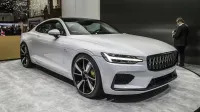Volvo spinoff reveals first car in Geneva: How will Polestar find its way?

It is sculpted, and muscular, like an Audi S5 that mated with an Aston Martin Vanquish. It will be produced in China in very limited numbers.
All of which begs the question: What is Polestar?
Well, it used to be Volvo’s in-house tuner shop, responsible for blattily souping up the motors and suspensions of otherwise staid sedans and wagons. But that’s over now. Sort of. The marque is still performance-oriented, and still uses Volvo platforms as its underpinnings — the 1 is built on a shortened version of the V90’s architecture. But in its new iteration, it is a standalone brand, dedicated to contemporary buzzwords such as sustainability, mobility and technology.
“We will focus on electric mobility and make it a reality by having something that is not just a dogmatic electric vehicle, but something that is desirable to drive,” says Thomas Ingenlath, the former Volvo design chief who has been tagged to run the brand. “As a startup, we get to experiment with new offerings and service and design that we couldn’t do at Volvo. We have a chance to do things that are not all-inclusive, that are more elite, edgy, higher profile. That are not for cars you buy for your family, but for yourself.”
Differentiation, as it turns out, requires infrastructural investment. In order for Lexus to signify luxury, it had to create a dealership experience that was intensely elevated from the quotidian one offered by Toyota. This was, as it turns out, one of its great successes and one of the reasons for its success. Conversely, General Motors’ decision to make Hummer a standalone brand, instead of a product line from, say, GMC, eventually ended up bankrupting that marque with its expense and overhead and requisite dissemination network. So how is Volvo/Polestar handling this?
“Polestar will be subscription service, 100 percent,” says Ingenlath. “We will not rely on big dealerships. Our communications with our customers will be direct, and our digital hub will connect with our customers directly. Of course we will have small Polestar spaces — downtown, not in every town but in the metropoles of the world. And we plan for customer-ordered production, not the other way around.”
With a designer at the helm of the brand, one would also expect design to be a significant standout, though Ingenlath continues to oversee that area for Volvo as well. The look of the 1 is certainly Volvo-esque in terms of many of its signature elements — headlamps, taillamps, grille, wheels. But its proportions separate it significantly, particularly in its long hood/short deck and its rather truncated greenhouse.
This final detail puts us in mind of the famed Volvo 262C coupe, a Bertone-designed, Italian-built, two-door sporting luxury version of the brand’s boxy 200-series sedan, but with a V6 engine and a 4-inch chop in its squared off, vinyl-padded roof.
“I can guarantee you absolutely no thought was given to giving this a vinyl roof,” Ingenlath says, laughing. “Maybe on the inside cladding, a headliner with a nice perforation … I could maybe see that.”
Related Video:




